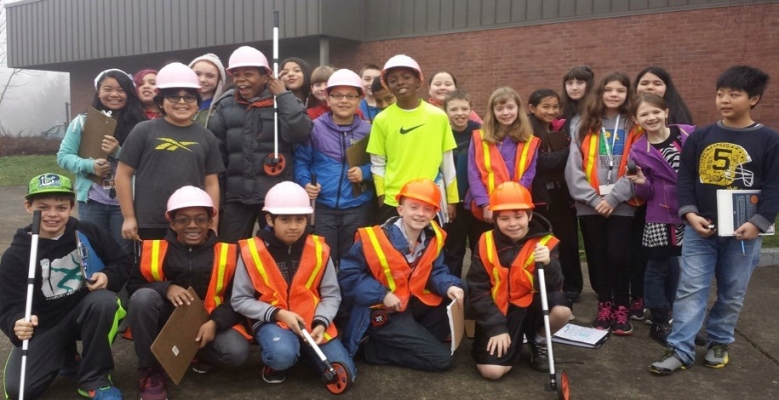Elementary Students Team up with Transportation Professionals in Parking Lot Redesign

In 2015, 5th grade classes at Beaverton’s Chehalem Elementary and 5th and 6th graders at Tobias Elementary in Aloha took part in a NITC education project, Investigations in Transportation, co-sponsored by Portland State University, the Portland Metro STEM Partnership and the Oregon Department of Transportation. The students' work yielded functional changes which will likely be made to the parking lots at both schools, resulting in better traffic flow and increased capacity. The unit was designed to teach students real-world applications of core concepts in STEM (science, technology, engineering and mathematics). After exploring several potential engineering challenges at their schools, both groups of students chose to work on the “Parking Lot Dilemma.” Read the full story below.
Two Oregon elementary schools recently had their parking lots redesigned by the students.
5th grade classes at Beaverton’s Chehalem Elementary and 5th and 6th graders at Tobias Elementary in Aloha took part in a NITC education project, Investigations in Transportation, co-sponsored by Portland State University, the Portland Metro STEM Partnership and the Oregon Department of Transportation.
The students' work yielded functional changes which will likely be made to the parking lots at both schools, resulting in better traffic flow and increased capacity.
William Becker, the director of PSU’s Center for Science Education, and Carol Biskupic-Knight began the NITC project in collaboration with the Portland Metro STEM Partnership, where Biskupic-Knight is the director of the STEM teachers academy.
The unit was designed to teach students real-world applications of core concepts in STEM (science, technology, engineering and mathematics). After exploring several potential engineering challenges at their schools, both groups of students chose to work on the “Parking Lot Dilemma.”
Transportation professionals from ODOT visited the classrooms, sharing their expertise and opinions on how to solve the problems of parking and congestion in their parking lots.
"I really liked it when the engineers came to our classroom. They brought us maps and designs. They were fun and happy to help us," Kadin, a 5th grader at Chehalem, said.
After consulting with the professionals, students put on hard hats and went outside to measure the lot, spaces and cars using measuring wheels and measuring tape.
Kailyn, another Chehalem student, loved the hands-on data collecting. "I really, really liked going outside to measure the parking lot and the cars and the spaces... I want to be a pediatrician, and that is a LOT of science," she said.
Jennifer LeCorre, who taught the unit at Tobias Elementary, believes that taking the lesson outside and immediately applying it helped her students connect the concepts they were learning, especially the math, to the real world.
“We lived it, breathed it, completely integrated it. It was a lot of fun and a lot of work. It was worth it seeing the level of engagement that the students had,” LeCorre said.
Wendy Gould, a 5th grade teacher at Chehalem Elementary, estimates that her students spent about 30-40 hours on the project.
“The students had a lot of interest in it, they were excited and very involved,” Gould said.
After researching the turning radius of cars and buses and exploring potential changes to the physical structure of the lot, Gould’s class turned to considering the parking lot’s usage. In researching district and state laws about the required hours for students in each grade to attend school, they found that one potential solution could be to stagger dismissal times, reducing the amount of congestion when parents come to pick up and drop off their kids.
They also looked into the state laws regarding accessible parking, discovering that their school had one more oversized disabled parking space than they needed. The extra space will be restriped and converted into two additional non-handicapped spaces, helping the lot to better accommodate its daily traffic.
Tobias will likely see changes to its parking lot as well, though probably not during the current school year.
“After the presentation, our principal and several of our STEM teachers walked out to the parking lot and started talking about changes that were possible. Several of our changes we were told were absolutely possible. Given how close it is to the end of the school year, we wouldn’t expect anything big to happen until next year,” LeCorre said.
In March 2015, Biskupic-Knight, Gould and LeCorre presented an overview of the unit development process and the project's outcomes at the National Science Teachers Association’s annual conference in Chicago.
The Beaverton School Board will recognize the Parking Lot Dilemma project as an exemplar of the Pillar of Innovation at their upcoming business meeting on Monday, April 27.
